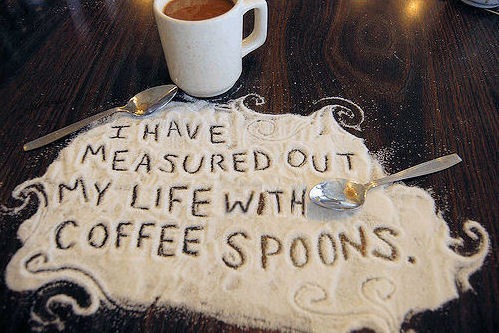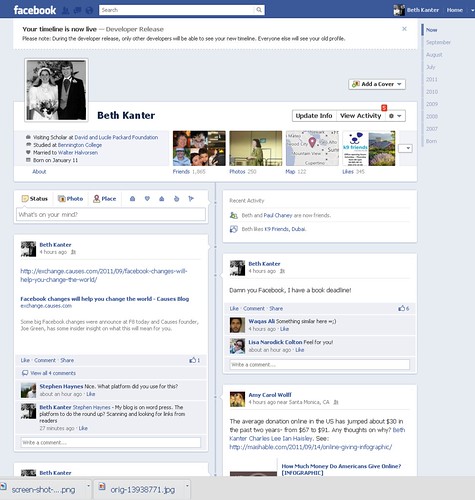
One of my favorite lines of poetry comes from TS Eliot’s The Love Song of J. Alfred Prufrock: “I have measured out my life with coffee spoons.” It comes in a spot in the poem where he talking about the passage of time and mundane events. I can’t resist quoting, bear with me:
In the room the women come and go
Talking of Michelangelo.
And indeed there will be time
To wonder, “Do I dare?” and, “Do I dare?”
Time to turn back and descend the stair,
With a bald spot in the middle of my hair—
(They will say: “How his hair is growing thin!”)
My morning coat, my collar mounting firmly to the chin,
My necktie rich and modest, but asserted by a simple pin—
(They will say: “But how his arms and legs are thin!”)
Do I dare
Disturb the universe?
In a minute there is time
For decisions and revisions which a minute will reverse.
For I have known them all already, known them all:
Have known the evenings, mornings, afternoons,
I have measured out my life with coffee spoons;
New Feature: The Timeline
Today was the big announcement at the F8 Conference about the new dramatic, life altering changes in the Facebook Platform. Facebook profiles are becoming fuller “timelines” of a one’s life. So, now, instead of measuring out your life in coffee spoons, you can post status updates with multimedia content in a tumbler like interface. (And your friends can post comments directly on the wall saying “But how your hair has grown thin” or the updated version of T.S. Eliot poetry.)
It is a major re-imaginging of user profiles that allows users to build a digital life book of everything they’ve done on Facebook. The timeline algorithmically organizes everything a user shares on Facebook — from photos to changes in relationship status to check ins — and also allows users to fill out a “Way Back” section to add details that are omitted or if they had a life before Facebook to add that information.

Here’s an example of what it will look like and how it will work and my own profile. (And if you don’t want to wait until the feature is rolled out, here’s how to do it.)
Causes posted this description of the potential impact on nonprofits:
Causes will be fully integrated into Timeline with “reports.” These reports will add up all of a person’s related actions on Causes into a larger story of how they are helping your organization. This means that your supporters can publicly support nonprofits on their profile and share their favorite nonprofit videos, projects, and other content with their friends. This means that when your supporters use Causes to take action — joining your causes, recruiting their friends, viewing and sharing videos you post, donating to and fundraising for your projects — their achievements will be permanently displayed on their Facebook profile for all of their friends to see. The average Facebook user has 150 friends, any of whom could be your next top supporter!
New Feature: More than Liking
The other change was that your friends and fans can do more than “Like” or “Comment” on Facebook. There are three new actions — Read, Watch, Listen — that will help people better understand what their friends are doing online. It’s the called the “Open Graph” and it changes the whole meaning of listening to music together or family T.V. Causes has re-launched their video player on Causes to ensure that nonprofits can leverage “Watch” action for a cause. (Causes is talking about creating create new types of actions on Facebook, such as Give and Pledge, which will allow them to prominently feature higher-value actions amidst the sea of less-impactful actions posted to Facebook everyday.)
Hmm .. what does that do to the ladder of engagement? Does it make more of a journey? Or will people be so flooded with everyone digital artifacts and actions from viewing each other timelines that they’ll not remember your organization? Will information overload prevent any tugging at the heart strings? I’ll get to that in a minute ….
The Potential for Oversharing: A Concern To Those Who Care About Privacy
My reaction was to either run screaming or say, wow this is cool. As we’ve seen, it takes time for mere mortals like our audiences to internalize these new ways of living or life streaming. Some will adopt more quickly than others depending on perhaps generational context, how set they are in their routines, and comfort level with openness and serendipity.
The best insight comes from colleague and friend, Francine Hardaway who write this for Fast Company
Ordinary people and small businesses using Facebook are going to come to grips with two new terms. The first is “self-expression,” which means your friends will know a lot more about what you read, what music you listen to, and even what you cook. The second is “serendipity,” which means if you see a friend of yours has watched a movie on Netflix, you can click on that app in your timeline and begin watching it immediately from within the app. This could lead to a great deal of inadvertent oversharing. Facebook’s new idea is to make its platform a 21st century form of scrapbooking, and to help you “scrapbook” your entire life “frictionlessly.” But you might want a little friction as you try to interact with all these changes.”
In some nonprofits – where they have encouraged more volunteers, staff, and others to represent the organization on Facebook – the barrier to doing that was, of course, not being comfortable with sharing that happened on the “old Facebook.” This will require some training and coaching on how to avoid oversharing on the new Facebook in using the timeline as well as how the apps work:
Be careful what apps you authorize, because by default, much of what you do on Facebook with apps, or even outside Facebook with Netflix and Spotify, and Facebook’s other integrated partners, will be shared automatically. Once you add an app to your timeline, you don’t have to give it permission to add stuff to your feed: “Adding an app to your timeline is like wiring a real-time connection between your app and Facebook…There is no step two,” says Facebook CTO Brett Taylor.
The good news is that Facebook’s new design is based on better data visualization. The bad news is that all that data is probably better for Facebook’s advertisers than for you. Remember that as long as you do not pay for Facebook, you are the product, not the customer.
Interestingly, Francine’s advice is not any different than in the past and what I’ve used when doing a training for those who are concerned about privacy, but not technologically savvy.
1.) Be careful who you friend.
2.) Carefully explore your privacy settings and make sure you understand
3.) Think twice about adding apps.
Changed Environment: Facebook Becomes The Internet
As Francine says below, with this new design changes, Facebook will become the Internet experience for many users – even if it is a walled garden. Francine talks about the implications on your marketing strategy in an environment of information overload and more noise:
“You will be encouraged by the new interface to make Facebook your permanent home on the internet, which means the “walled garden” is pulling more partners in, rather than helping you get out to the wider world. So if you are a business, and you have a Facebook presence, you are going to need a much broader Facebook marketing strategy in order to find your new customers solely within the Facebook platform. Well, the good news is that 800,000,000 from all over the world are now on Facebook. The bad news is that creates a lot of noise, and doesn’t necessarily help you reach the “right” people, especially since Facebook search is notoriously inferior.
I was curious what nonprofit colleagues were thinking. Wendy Harman was curious about what the implications were for branded pages and John Haydon posted the above screencast. He also noted that people can participate on your FB page without having to “like” it. This points to what Francine discussed about – having a broader strategy beyond Facebook to connect with potential and current audiences. It means having compelling and engaging content, sharing your story, understanding what motivates and inspires your audience, and having Facebook be a part of a multi-channel effort. Also, it means having good content curation skills and being able to engage with your audience – not just passively fling content at them.
What do you think?
